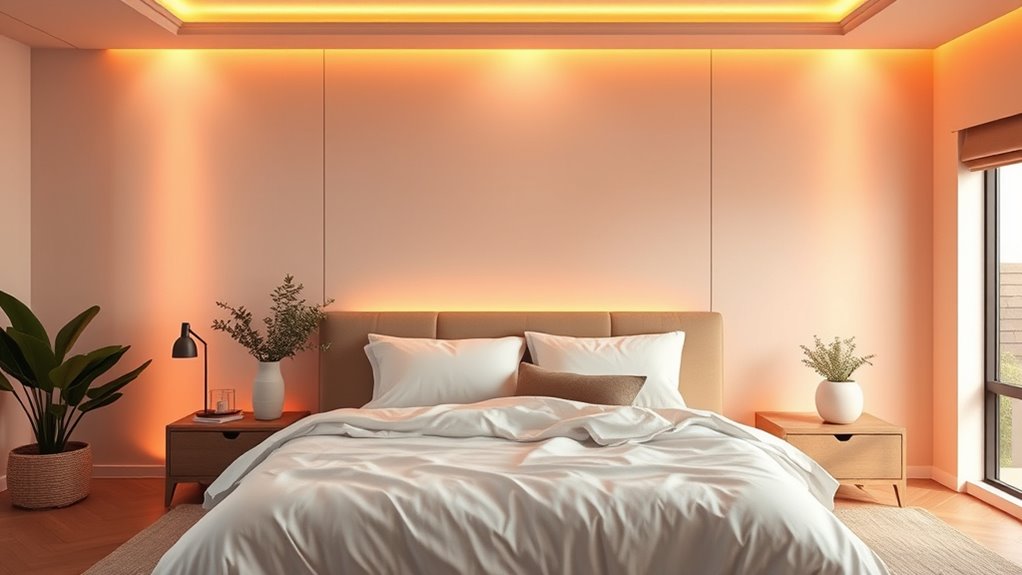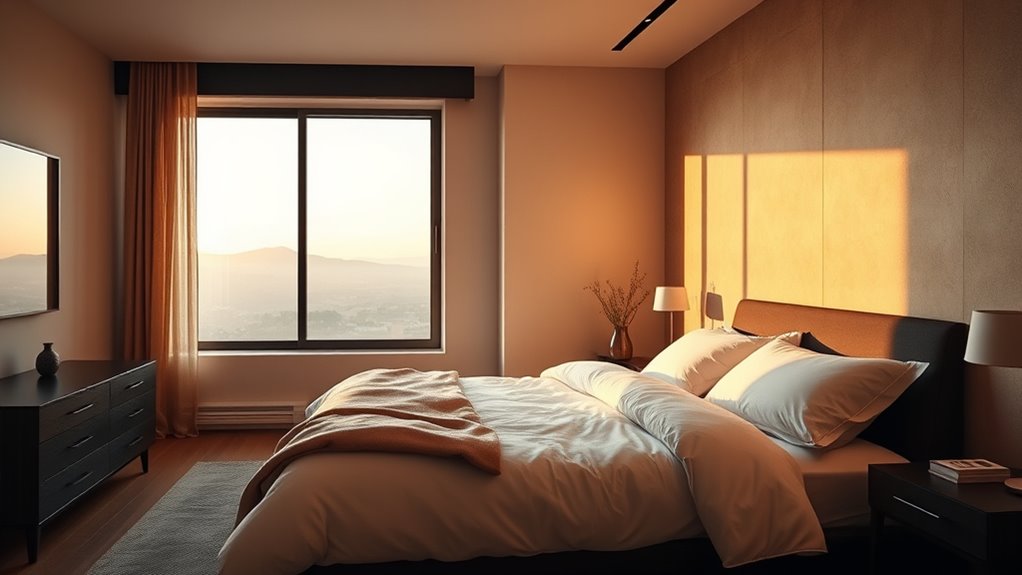Smart lighting that syncs with your circadian rhythm adjusts color temperature and brightness throughout the day to match your body’s natural internal clock. In the morning, it uses bright, cool light to boost alertness, while evenings shift to warm, dimmer tones that promote relaxation and sleep. By programming these changes automatically, you can enhance your overall well-being, sleep quality, and mood. Keep exploring to discover how precisely this technology can support your daily rhythm.
Key Takeaways
- Smart lighting systems can automatically adjust color temperature and brightness to mimic natural daylight patterns.
- Circadian-synchronized lighting changes from cool, bright light in the morning to warm, dim light in the evening.
- Programmable lighting routines support hormone regulation and improve sleep-wake cycles.
- Integrating lighting with routines enhances alertness during the day and relaxation at night.
- Automated lighting controls help maintain a healthy biological clock without manual adjustments.

Understanding your body’s natural clock can considerably improve your well-being, and lighting that syncs with your circadian rhythm makes this possible. Your circadian rhythm governs your sleep-wake cycle, hormone production, and overall alertness. When your environment’s lighting aligns with this internal clock, you experience better sleep, increased energy, and enhanced mood. This is where smart lighting comes into play, allowing you to customize your lighting environment to support your natural rhythms. One key aspect to contemplate is color temperature, which impacts how your body perceives light and influences your circadian signaling.
Color temperature is measured in Kelvin (K) and determines whether light appears warm or cool. Warm light, with a lower Kelvin rating (around 2700K-3000K), mimics sunset and sunrise, promoting relaxation and preparing your body for sleep. Cooler light, with higher Kelvin values (above 5000K), resembles daylight and helps boost alertness during the day. Smart lighting systems let you adjust the color temperature throughout the day, creating a lighting schedule that aligns with your natural rhythms. In the morning, you can set your lights to emit a bright, cool light to help you wake up feeling refreshed and alert. As the day progresses, gradually shifting to warmer tones can signal your body to wind down, easing you into a restful evening.
Using smart lighting provides precise control, so you don’t have to manually change bulbs or rely on inconsistent fixtures. You can program your lights to adapt automatically based on the time of day or your routine, ensuring your environment supports your circadian health. This dynamic adjustment helps regulate melatonin production, the hormone responsible for sleep, by mimicking natural light patterns. When your lighting changes in harmony with your body’s needs, you’re less likely to experience sleep disturbances or fatigue. Additionally, understanding the significance of light quality can further enhance how effectively your environment supports your biological clock.
Furthermore, the integration of smart lighting with other smart home devices can optimize your daily routine. For instance, your lights can gradually brighten in the morning, simulating a sunrise, or dim in the evening to prepare you for bed. This seamless experience enhances your overall well-being without requiring extra effort on your part. By paying attention to color temperature and harnessing the capabilities of smart lighting, you empower your environment to work with your body’s natural timing. In doing so, you create a healthier, more balanced lifestyle that respects your circadian rhythm and promotes better sleep, mood, and productivity.
Frequently Asked Questions
How Does Circadian Rhythm Lighting Affect Sleep Quality?
Your sleep quality depends heavily on your circadian rhythm, which regulates your sleep cycle. When your environment supports this rhythm with proper lighting, it helps maintain melatonin regulation, making it easier to fall asleep and wake refreshed. Conversely, poor lighting can disrupt your sleep cycle, reducing melatonin production and causing restless nights. Properly synced lighting ensures your body’s natural rhythm stays aligned, improving overall sleep quality.
Can Circadian Lighting Improve Productivity at Work?
Boosting your brainpower begins with your work environment. When you optimize light intensity, you can often improve productivity. Circadian lighting, which mimics natural light, helps regulate your alertness and energy levels throughout the day. By using well-designed lighting that adapts to your body’s rhythm, you stay sharper longer, reducing fatigue and fostering focus. So, yes, the right lighting can markedly enhance your work performance and overall productivity.
What Are the Best Types of Bulbs for Circadian Synchronization?
You should look for bulbs with adjustable color temperature, which can shift from cool to warm tones throughout the day. This helps your body sync with natural rhythms. Opt for energy-efficient LED bulbs with a color temperature range of 2700K to 6500K. These bulbs are versatile, cost-effective, and support circadian health by providing the right light at the right time, improving mood and alertness.
Are There Any Health Risks Associated With Circadian Lighting?
You might wonder about health risks related to circadian lighting. While it’s designed to support your sleep and well-being, some concerns exist regarding health implications and long-term effects. Overexposure to certain wavelengths or improper timing could disrupt your natural rhythms. However, when used correctly, circadian lighting is generally safe and beneficial. Always follow manufacturer guidelines and consult a healthcare professional if you have specific health conditions.
How Customizable Are Circadian Lighting Systems for Individual Needs?
You’ll find that circadian lighting systems offer impressive customization through personalization options and adjustable settings. You can tailor brightness, color temperature, and timing to suit your individual needs and daily routines. Many systems allow you to set preferences for different times of day, ensuring ideal comfort and health. With these flexible features, you get a lighting experience that seamlessly adapts to your lifestyle, promoting better well-being and productivity.
Conclusion
By embracing lighting that syncs with your circadian rhythm, you’ve taken a step toward better sleep, improved mood, and overall wellness. Remember, a healthy mind and body start with small changes, like aligning your environment with nature’s clock. As the saying goes, “The early bird catches the worm.” So, let this innovative lighting guide you to brighter days and restful nights, proving that sometimes, the simplest shifts can make the biggest difference.









